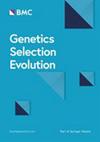对增加身高的突变的选择性扫描阻碍了对牛的生育力和其他相关性状的致病突变的识别
IF 3.1
1区 农林科学
Q1 AGRICULTURE, DAIRY & ANIMAL SCIENCE
引用次数: 0
摘要
肥力、生长和体成分是肉牛盈利能力的关键驱动因素。为了确定这些性状变异的致病突变,我们对28,351头多品种肉牛进行了多性状全基因组关联分析(M-GWAS),并对使用相同WGS变异的489头牛进行了表达数量性状位点(eQTL)汇总统计。另一个目的是深入了解生长、新陈代谢和生殖发育之间关系的生物学基础。首先,我们在约600天对母牛的活重、臀高、体况评分和青春期进行了M-GWAS。随后,我们将重点放在先导GWAS SNP周围的2 Mb区域,确定了每个区域的顶部eQTL。通过迭代条件分析,我们将这些变异依次整合到单个单性状GWAS中,并利用条件和联合GWAS分析进一步分析表达和性状信息。这一迭代过程一直持续到M-GWAS中没有出现额外的显著snp。共鉴定出15个候选基因,包括IRAK3、HELB、HMGA2、LAP3、FAM184B、LCORL、PPM1K、ABCG2、MED28、PLAG1、BPNT2、UBXN2B、CTNNA2、SNRPN和SNURF。当我们研究血液中与这些基因相关的eQTL数量时,IRAK3、HELB、PPM1K、ABCG2、MED28、BPNT2和UBXN2B与单个eQTL相关,而ABCG2明显与两个eQTL相关(Bonferroni校正P < 1 × 10-10)。然而,这些区域潜在qtl的鉴定受到广泛的局部连锁不平衡的阻碍。对这些区域扩展单倍型纯合性的分析显示,这种扩展连锁不平衡可能是近期强选择的结果,在大多数情况下,等位基因的高度增加(χ 2 P = 0.000967)。这一观察结果在一定程度上解释了为什么在牛身上很难识别影响生育力的突变,以及其他与身高有关的多效性特征。本文章由计算机程序翻译,如有差异,请以英文原文为准。
Selective sweeps for mutations increasing height impede identification of causative mutations for fertility and other correlated traits in cattle
Fertility, growth and body composition are key drivers of profitability in beef cattle. With the aim of identifying causative mutations underpinning variation in these traits, we integrated multi-trait genome-wide association analysis (M-GWAS) in a cohort of 28,351 multibreed beef cattle with imputed whole genome sequence (WGS) data, with expression quantitative trait loci (eQTL) summary statistics from 489 indicine cattle using the same WGS variants. An additional aim was to provide insights into the biological basis for the association between growth, metabolism, and reproductive development. First, we conducted M-GWAS for live weight, hip height, body condition score and heifer puberty at approximately 600 days. Subsequently, focusing on a 2 Mb region around the lead GWAS SNP we identified the top eQTL in each region. Through iterative conditional analysis, we successively integrated these variants into individual single trait GWAS and further analysed expression and trait information using conditional and joint GWAS analysis. This iterative process continued until no additional significant SNPs emerged from the M-GWAS. Fifteen candidate genes were identified, including IRAK3, HELB, HMGA2, LAP3, FAM184B, LCORL, PPM1K, ABCG2, MED28, PLAG1, BPNT2, UBXN2B, CTNNA2, SNRPN, and SNURF. When we investigated the number of eQTL in blood associated with these genes, IRAK3, HELB, PPM1K, ABCG2, MED28, BPNT2, and UBXN2B were associated with a single eQTL, while ABCG2 was clearly associated with two eQTLs (Bonferroni corrected P < 1 × 10–10). However, the identification of potential QTLs in these regions was impeded by extensive localised linkage disequilibrium. Analysis of extended haplotype homozygosity in the regions revealed this extended linkage disequilibrium was likely the result of recent strong selection, in most cases for the allele increasing height (Chi-square P = 0.000967). This observation sheds some light on why it has been so difficult to identify mutations affecting fertility, and other traits that are pleiotropic with height, in cattle.
求助全文
通过发布文献求助,成功后即可免费获取论文全文。
去求助
来源期刊

Genetics Selection Evolution
生物-奶制品与动物科学
CiteScore
6.50
自引率
9.80%
发文量
74
审稿时长
1 months
期刊介绍:
Genetics Selection Evolution invites basic, applied and methodological content that will aid the current understanding and the utilization of genetic variability in domestic animal species. Although the focus is on domestic animal species, research on other species is invited if it contributes to the understanding of the use of genetic variability in domestic animals. Genetics Selection Evolution publishes results from all levels of study, from the gene to the quantitative trait, from the individual to the population, the breed or the species. Contributions concerning both the biological approach, from molecular genetics to quantitative genetics, as well as the mathematical approach, from population genetics to statistics, are welcome. Specific areas of interest include but are not limited to: gene and QTL identification, mapping and characterization, analysis of new phenotypes, high-throughput SNP data analysis, functional genomics, cytogenetics, genetic diversity of populations and breeds, genetic evaluation, applied and experimental selection, genomic selection, selection efficiency, and statistical methodology for the genetic analysis of phenotypes with quantitative and mixed inheritance.
 求助内容:
求助内容: 应助结果提醒方式:
应助结果提醒方式:


